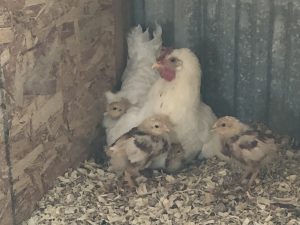Mom is the best teacher. That’s true with both people and chickens.
While a mother hen is teaching her chicks, she can also instruct observant people.
Years ago, most baby chicks had the good fortune to have a mom. In those preindustrial days broody hens patiently sat on fertile eggs for 21 days until they miraculously hatched into peeping babies. Then, for the next couple of months, she kept them warm, protected them from danger, and taught them how to choose a healthy and balanced diet.

That’s not common today. Nearly all baby chicks are hatched in incubators and never enjoy the comfort or instruction of a mom. Chicks from a farm store or ordered through the mail never knew a mother. They depend on people to keep them safe and provide nutritious food. Commercial starter/grower feed makes feeding easy. It contains all the nutrients chicks need to thrive, but like adult chickens and people the babies love snacks.
Adult chickens are adept recyclers. Hens quickly gobble up bits of rice, scraps of pasta, cookie crumbs, leftover salad, and other human foods that would otherwise head to the landfill. They seem to instinctively know what’s good to eat and what isn’t. For example, toss bread chunks into the run and they will be enthusiastically devoured, while nearby citrus fruit is ignored.
Chicks haven’t gained life experience to know what foods are good to eat. Like hens they enjoy diet diversity, but adding greens or kitchen scraps into a brooder filled with youngsters should be approached with caution.
Mother hens lead their chicks about the yard and introduce them to the wide world. She’ll scratch in dirt, mulch, or grass, take a couple of steps backward, and if she spots tasty safe seeds, greens or bugs with a special cluck, she’ll summon her babies to chow down. Under mom’s monitoring even three- or four-day old chicks eat a diverse and balanced diet. Insects and seeds provide protein while greens add vitamins and some calories.
Mom’s secret is providing a nutritious and diverse diet in moderation. Human parents do the same thing, encouraging children to eat vegetables while going easy on sugary sweets or salty chips.
Since brooder chicks don’t have mom to guide their diet humans must make sure they eat properly. Chicks should always have commercial mash available but it can be supplemented with occasionally tasty treats. They’ll peck at bits of salad greens, rice scraps, and other kitchen waste. Caution is needed.
Moderation is important. Mature hens know what’s good to eat and when to stop. Chicks may not and most of their diet should come from the commercial mash. Introduce new diverse foods into the brooder sparingly. The right portion is what they’ll eat in just a minute or two.

Most kitchen scraps fed to chickens hold a lot of water. Moisture is a catalyst for disease. If the chicks don’t eat moist tidbits quickly remove them and always keep the brooder dry. Remember, food scraps are snacks, not the prime diet.
Like most birds (owls are an exception) chickens need grit in their gizzard so these toothless animals can pulverize food. Chicks eating only commercial feed may not need much grit, but once they begin eating harder food it is essential. A few pinches of fine sand sprinkled in the brooder gives the tiny birds grit that helps them digest treats.
Like people, chickens of all ages love diet diversity. This diversity can come from kitchen scraps or even garden weeds, but they’re best enjoyed in moderation.